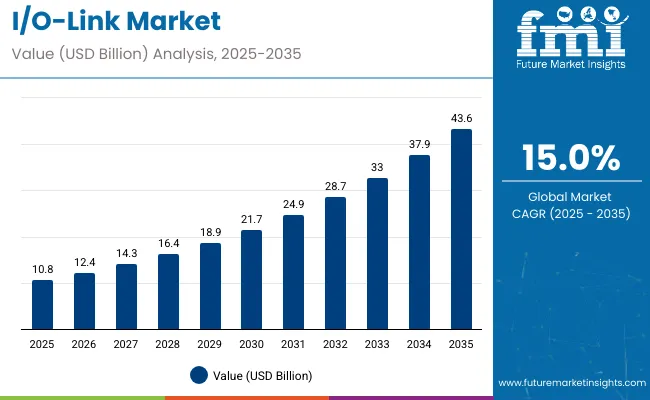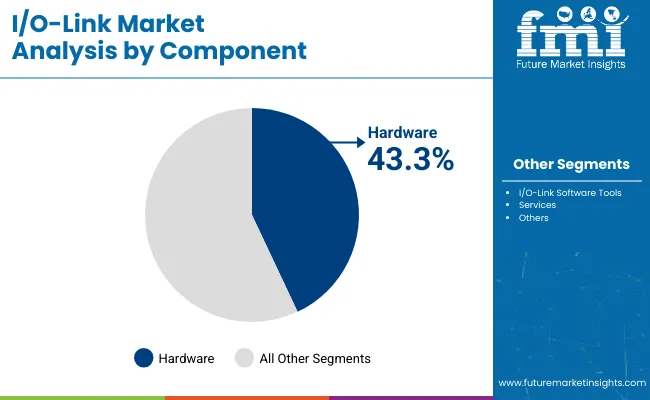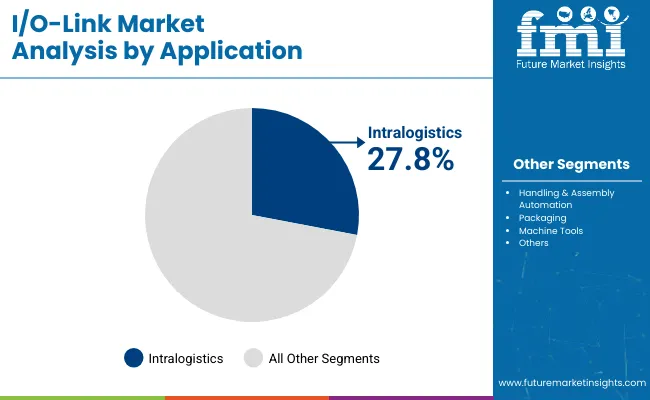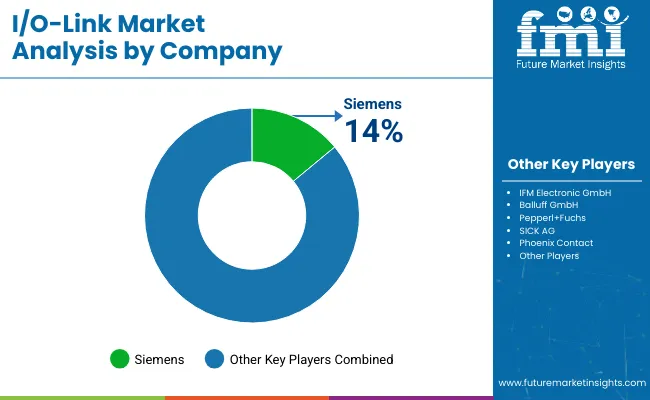The global I/O-Link market is projected to grow significantly from USD 10.8 billion in 2025 to USD 43.6 billion by 2035, reflecting a CAGR of 15% over the forecast period. This growth has been supported by the increasing demand for standardized communication protocols in industrial automation. By 2025, accelerated adoption was observed in manufacturing hubs across North America, Europe, and East Asia, where automation and smart factory investments are expanding rapidly.
I/O-Link technology enables seamless communication between sensors, actuators, and control systems in industrial environments. The protocol’s simplicity, interoperability, and real-time diagnostics capabilities have led to its widespread application in smart manufacturing, logistics, and automotive sectors. In 2024, industrial system integrators reported growing interest in I/O-Link for retrofitting legacy equipment and supporting scalable data analytics.
Hardware components continue to dominate the market, with a wide portfolio of master modules, sensors, hubs, and converters facilitating point-to-point connections. These components are preferred for their plug-and-play setup and reduced commissioning time. In 2025, enhanced compatibility with both analog and digital signals has further improved deployment across different factory environments.
Intralogistics is emerging as a high-growth application area, with companies seeking real-time inventory control, conveyor management, and warehouse robotics integration. I/O-Link’s compatibility with Industry 4.0 frameworks has made it particularly useful for data-intensive environments. Meanwhile, the automotive and transportation industry is deploying the protocol to streamline assembly operations and reduce machine downtime, helping to achieve just-in-time production goals.
Vendors such as Siemens, Balluff, Rockwell Automation, and IFM electronic are investing in open software tools, cloud integration, and edge intelligence to broaden I/O-Link’s capabilities. New product launches in 2025 focused on IP67-rated master devices, faster data transmission, and remote parameterization.
Recent strategies across major players indicate that I/O-Link is central to future-ready automation ecosystems. With smart factories advancing globally, the technology is expected to play a foundational role in enhancing asset visibility, reducing downtime, and supporting predictive maintenance.

| Attributes | Key Insights |
|---|---|
| Estimated Size, 2025 | USD 10.8 billion |
| Projected Size, 2035 | USD 43.6 billion |
| Value-based CAGR (2025 to 2035) | 15.0% |
The I/O-Link system has undergone a significant cleanup with the latest specification updates. Interoperability issues that once caused friction are being ironed out, and device behavior is now clearer and more predictable. On top of this, the smart sensor profile has been strengthened, meaning tools and libraries can interpret sensor data consistently across vendors. This shift reduces engineering overhead and makes multi-vendor setups more practical.
Wireless I/O-Link has reached a level of maturity where it works well for defined use cases. Cycle times around five milliseconds and robust interference management allow it to support many sensor and actuator applications without running cables. The reality, however, is that it is not a high-performance motion bus. Bandwidth and node counts remain limited, so its role is best understood as a reliable cable replacement rather than a step into time-sensitive networking.
I/O-Link Safety has moved from theory into real deployment. It now supports functional safety at the highest levels, and vendors are shipping modules that can carry safety protocols through standard I/O-Link into existing safety PLCs. The benefit is a streamlined path to integrate safety devices into modern architectures. The challenge remains that the ecosystem is still smaller than traditional safety I/O, and integrating components from different vendors requires careful engineering discipline.
New integration profiles are making northbound connectivity far cleaner. JSON-based models allow devices and masters to push data into MES and cloud platforms without custom code, while companion specifications for OPC UA ensure seamless mapping into industrial information models. This is where much of the innovation is heading: reducing the reliance on proprietary SDKs and enabling a straightforward IT/OT bridge that can scale as enterprises expand their digital initiatives.
The below table shows the expected CAGR for the global I/O-Link market over few semi-annual periods, which covers 2025 to 2035. In the first half H1 over the years from 2024 to 2034, the business is predicted to surge at a CAGR of 14.2%, followed by a marginally higher growth rate of 14.8% in the second half H2 of the same decade.
| Particular | Value CAGR |
|---|---|
| H1 2024 | 14.2% (2024 to 2034) |
| H2 2024 | 14.8% (2024 to 2034) |
| H1 2025 | 15.6% (2025 to 2035) |
| H2 2025 | 14.9% (2025 to 2035) |
Moving into the subsequent period, from H1 2025 to H2 2035, the CAGR is projected to increase considerable to 15.6% in the first half and remain relatively moderate at 14.9% in the second half. In the first half H1 the market showcased an increase of 10 BPS while in the second half H2, the market witnessed a decrease of 20 BPS.

By component, the hardware segment is projected to account for 43.3% of the global market by 2035. In 2025, hardware already leads in adoption due to its role in enabling the core communication infrastructure for sensors and actuators. Modules, hubs, and connectors equipped with I/O-Link interfaces are being widely deployed to reduce wiring complexity and support plug-and-play diagnostics.
These components are designed for durability, fast configuration, and seamless retrofitting. Software and services, while smaller in share, are gaining traction for enabling device management, predictive maintenance, and protocol translation.
In 2024 and 2025, vendors began launching edge-capable devices with embedded processing and cloud integration features. While software and analytics tools are increasingly valuable for factory insights, hardware will remain the backbone of deployment as Industry 4.0 adoption spreads.
Compact design, IP-rated enclosures, and interoperability with various fieldbuses continue to define hardware innovation. As manufacturing digitization accelerates, the demand for reliable, intelligent I/O-Link hardware is expected to remain high across both greenfield and brownfield projects.

Among applications, intralogistics is projected to capture 27.8% of the market by 2035 and is expected to grow at a CAGR of 16.1%. In 2025, smart warehouses, e-commerce fulfillment centers, and factory logistics departments are adopting I/O-Link to manage complex conveyor systems, sorters, and robotics. The need for real-time sensor communication, fault tracking, and condition monitoring is driving rapid integration of the protocol. Compared to machine tools or packaging lines, intralogistics environments demand higher flexibility and faster response times.
I/O-Link-enabled sensors and actuators support modular layouts and facilitate quick changeovers-vital for dynamic product flows. 2024 saw major warehousing operations in Europe and China adopt I/O-Link master systems with remote diagnostics. Wireless variants and decentralized control are also becoming attractive.
While packaging and machine tools remain large contributors, intralogistics stands out for its pace of growth and strategic role in end-to-end supply chain automation. With increasing investments in warehouse robotics and AGVs, the I/O-Link application footprint in this segment is expected to grow considerably.
In the manufacturing sector, I/O link is very vital since the technology involves communication between the devices being utilized in the production. The factories within the manufacturing industry use I/O link technology to enhance predictive maintenance. This is because utilizing such an innovation gives them a chance to improve the schedules of maintenance and reduce uncertain failure of the machines.
Automotive manufacturers have become particularly dependent on IO-Link systems. Assembly lines equipped with IO-Link technology achieve unprecedented levels of precision. These advanced communication systems connect countless sensors and actuators throughout the production process, maintaining the exacting standards required by modern vehicle manufacturing.
Pharmaceutical production facilities face unique challenges that IO-Link technology directly addresses. Clean rooms and production areas require constant environmental monitoring.
Plant operators rely on IO-Link systems to track critical measurements like temperature fluctuations and humidity levels. The technology ensures compliance with strict regulatory requirements while maintaining the sterile conditions essential for pharmaceutical manufacturing.
The reach of IO-Link continues to expand beyond traditional manufacturing. Warehouse operators use the technology to manage complex logistics operations. Food and beverage producers depend on IO-Link to maintain safety standards.
Power plants and utility providers integrate these systems into their infrastructure. This broad adoption across multiple sectors reflects the growing recognition of IO-Link as an essential component of modern industrial operations.
Lack of standardization and restriction of I/O-Link in high-speed or motion control applications, and issues with the use of basic sensors are expected to obstruct market growth. The disadvantage of the I/O-Link is the complexity leading to increased hardware and software design costs such as expensive shielded cabling. On the other hand, consumption of compact machines is also the major factor restraining the market growth.
IO link solution help reduce cables and wiring for industrial machines. Manufacturing industries demand compact and reliable solutions for their operational processes. This leads to the requirement of compact machines on a factory floor. Such compact machines, apart from being small, consume less power and offer better performance as compared with other industrial solutions.
Also, the wiring in compact machines is already short. In such cases, deploying I/O-Link solutions is costlier for industry players. In addition, these machines are efficient and require lesser space than traditional machines and other industrial solutions. Hence, the use of compact machines for industrial automation is a major hurdle for the growth of the market.
With its integration capabilities, IO-Link is looking promising in the landscape of industrial automation. Moving forward, the number of industries that continues to adapt smart manufacturing technologies are not only expected to rise but increase quite rapidly. This is due to the I/O-link support for predictive maintenance and condition monitoring in the modern manufacturing environments.
On the other hand, the continuous developments in the I/O-Link master devices with versatile features and lucrative functionalities are expected to open new roads for innovation. Further innovation and developments in the technology are expected to widen the range of integrations of I/O-link to more complex systems, which will eventually broaden its applications and highlight it as a fundamental technology in industrial communication and automation.
Hence, with industries move towards smart manufacturing practices, the I/O-Link technology holds the potential to bring industrial communication in transition. As it brings efficiency, innovation and sustainability in the manufacturing landscape, I/O-Link stands out as an essential component in the evolving setting of industrial communication.
Though, the pandemic impacted the market due to the supply chain disruptions among other factors; the industry still grew at a decent pace. The stability in the automotive sector played a crucial role in the growth displayed by the market. The regions such as North America and Western Europe have a stable automotive industry which had a direct positive impact on the demand of the I/O-Link.
According to IEEE the number of global IoT connections worldwide will exceed USD 75 Billion by 2026. The primary factor is due to the ability of this technology to provide various benefits, such as rapid returns on investment, safe commissioning, reliable packaging processes, improved remote diagnosis, and easy availability of the final packaging machines.
These beneficial properties of I/O-Link are expected to propel its demand in the upcoming years. I/O-Link also helps in optimizing the packaging process by setting up bidirectional communication between automation systems and sensors. This is also expected to drive the market growth of I/O-Link market in the long term.
Tier 1 companies includes companies that are performing as market leader in the I/O-Link market. These companies are providing wide range of solutions and have a very large customer base in the concerned market. These top vendors focus on promoting research and development while innovating futuristic technologies in the mentioned market. The companies in the bracket includes such as Siemens, Rosemount (Emerson), Omron Corporation, Phoenix Contact and SICK AG.
Tier 2 companies consists of those mid-sized players that might not provide a very broad portfolio of the I/O-link technology offerings but have a very respectable share in the market.
These companies often focus on making partnerships and collaborations in order to maximize their customer portfolio meanwhile this also keeps them in loop about any innovation and product launches. Although, these companies themselves also try to launch the new products in order to broaden their solution portfolio. The companies in the tier are ifm electronic, Balluff GmbH, Baumer and others.
Tier 3 companies are the companies which are still trying to achieve stability in the market or these companies might be established recently. These companies are primarily focuses on partnerships and their product portfolio. The companies in the tier include Banner Engineering Corp, Hans Turck GmbH & Co. KG and others.
The section below includes the industry analysis of I/O-Link market over the countries in North America, Latin America, East Asia, South Asia & Pacific, Western Europe, Eastern Europe and Middle East & Africa. The analysis describes the country wise analysis that are expected to grow at a high CAGR. The USA in North America is expected to hold the market share around 68% in the year 2035. Meanwhile, India is expected to grow at a high CAGR of 18.0% over the forecasted period

| Countries | Value CAGR (2025 to 2035) |
|---|---|
| USA | 14.3% |
| Brazil | 14.0% |
| Germany | 14.6% |
| India | 18.0% |
| China | 15.7% |
The market is expected to grow further as per FMI analysis, the adoption rate of remote and maintenance services in Germany for last couple of years is around 47%, quite higher than the global adoption rate, which stands on 30%.
This is due to the very strong industrial sector presence in Germany. Industries such as manufacturing and automotive require high level digital networking between devices in order to go through seamless production. Businesses in the Germany are utilizing I/O-link for digital data transfer and seamless communication ranging from the control level to sensor lever. For example, German car manufacturing company BMW uses I/O link technology to ensure the precise control of painting and assembly lines in their production plants.
Automation solutions company Bosch Rexroth also uses I/O link technology to obtain real-time diagnostics and predictive maintenance data. Siemens on the other hand, integrates I/O link technology into their smart factory solutions to support advanced manufacturing techniques.
North America, led by the USA currently holds around 17.7% share of the global I/O-Link industry in 2024. This is due to the rising Industrial IoT (IIoT) and consumer IoT connections in the country. As per FMI analysis, by 2023, the number of IIoT connections has exceeded USD 230 Million while there are more than USD 550 Million consumer IoT connections in the country.
The presence of a well-established packaging sector in the USA is projected to bolster the North America IO-link technology market growth in the future years. The sector uses automation solutions to initiate multiple packaging processes, such as product shipment, storage, handling, and sorting.
IO-link technology also helps in optimizing the packaging process by setting up bidirectional communication between automation systems and sensors. This technology provides various features, such as rapid returns on investment, safe commissioning, reliable packaging processes, improved remote diagnosis and easy availability of the final packaging machines.
In China, IO-Link is a major enabling force for Industry 4.0 & smart manufacturing. Motivations for flexible manufacturing, efficient production and visibility require that have more diagnostics and data available for analysis and monitoring.
Lot-size-one flexible manufacturing requires that sensors and field devices be able to adapt to a rapidly changing set of requirements. With the parameterization feature of IO-Link slave devices, companies can now send new parameters for production to the sensor on a part by part basis if required. With China being a huge manufacturing base, the demand for I/O link keeps on growing at a considerable CAGR over the forecast period.
The growing IIoT deployments that use IO-Link in smart factories to gather data from production lines and sensors for in-the-moment analytics and decision-making happens to be another major factor driving market growth in the China.
The market in China is expected to grow at a high CAGR of 15.7% over the forecasting period. According to IEEE, the number of IoT connections in China has exceeded USD 1.8 Billion by the end of 2022. The rising number of connections have established China as global market leader in the IoT industry.

Key players operating in the I/O-link technology market are focusing on investing in research and development in order to innovate new technologies. The companies are also expanding their global reach for tapping the market that has yet to be dominated by other vendors.
| Report Attributes | Details |
|---|---|
| Current Total Market Size (2025) | USD 10.8 billion |
| Projected Market Size (2035) | USD 43.6 billion |
| CAGR (2025 to 2035) | 15.0% |
| Base Year for Estimation | 2024 |
| Historical Period | 2020 to 2024 |
| Projections Period | 2025 to 2035 |
| Quantitative Units | USD billion for value; Thousand units for hardware component volume |
| Product Types Analyzed (Segment 1) | Hardware, I/O-Link Software Tools, Services |
| Applications Analyzed (Segment 2) | Handling & Assembly Automation, Packaging, Machine Tools, Intralogistics, Others |
| Industries Analyzed (Segment 3) | Pharmaceuticals, Electronics & Electricals, Automation & Transportation, Food & Beverages, Energy & Utilities and Others. |
| Regions Covered | North America; Latin America; Western Europe; Eastern Europe; South Asia and Pacific; East Asia; Middle East & Africa |
| Countries Covered | United States, Canada, Germany, United Kingdom, France, Japan, China, India, South Korea, Brazil |
| Key Players Influencing the Market | Pepperl+Fuchs, ifm electronic GmbH, Baumer, Balluff GmbH, Siemens, Rosemount (Emerson), Phoenix Contact, SICK AG, Leuze electronic GmbH + Co. KG, Omron Corporation, Hans Turck GmbH & Co. KG, Banner Engineering Corp |
| Additional Attributes | Rapid industrial automation, High adoption in automotive and logistics, Scalability and integration with Industry 4.0 platforms |
| Customization and Pricing | Customization and Pricing Available on Request |
In terms of components, the industry is segmented into hardware, I/I-Link software tools and services.
In terms of application, the industry is segregated into handling & assembly automation, packaging, machine tools, intralogistics and others.
The industry is classified by pharmaceuticals, electronics & electricals, automation & transportation, food & beverages, energy & utilities and others.
Key countries of North America, Latin America, East Asia, South Asia & Pacific, Western Europe, Eastern Europe and Middle East and Africa (MEA) have been covered in the report.
The global I/O-link technology industry is projected to witness CAGR of 15.0% between 2025 and 2035.
The global I/O-link technology industry stood at USD 8.3 billion in 2024.
The global I/O-link technology industry is anticipated to reach USD 43.6 billion by 2035 end.
South Asia & Pacific is set to record the highest CAGR of 16.2% in the assessment period.
The key players operating in the global I/O-link technology industry include Emerson, SICK AG, Siemens, Phoenix Contact, Omron Corporation among others.






Full Research Suite comprises of:
Market outlook & trends analysis
Interviews & case studies
Strategic recommendations
Vendor profiles & capabilities analysis
5-year forecasts
8 regions and 60+ country-level data splits
Market segment data splits
12 months of continuous data updates
DELIVERED AS:
PDF EXCEL ONLINE

Thank you!
You will receive an email from our Business Development Manager. Please be sure to check your SPAM/JUNK folder too.
Chat With
MaRIA